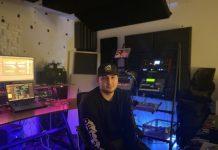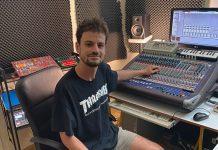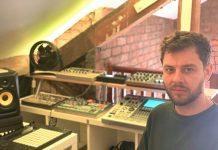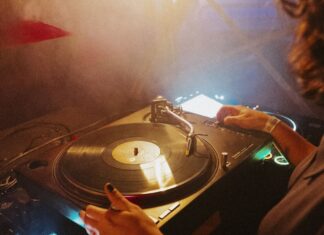Having recently joined Michael James in the main setup at The Source it seemed only right for Fuse London mainstay Rich NxT to produce a tutorial. On the latest edition, Rich shows how he goes from loop to track and a few more juicy tips and tricks he has picked up along the way. Ahead of checking out his tutorial Rich gives us the lowdown on his offering for The Source…
Can you tell us about your tutorial in depth?
I wanted to really show how I approach making the core loop of a track because I often get asked about this. I try lots of different sounds and experiment with varying the sequenced patterns. I use Drum Racks in Ableton for the drum and percussion sounds, which are powered by samples. For the bass and synths I am using an externally MIDI connected Yamaha AN-200. I have been working with MIDI for many years, since I was at school and using Cubase and Pro24 on the Atari ST. MIDI is still one of my favourite studio concepts. To be able to connect external equipment, trigger it with your keyboard and record it with your DAW is so powerful. You are then hands free to tweak the settings on the gear ( in this case the AN-200) until you find a sound. You can then very easily bounce this down to multiple audio tracks.To create the sequences I have drawn in notes in Ableton midi parts. I use this technique almost as much as I play notes in with a keyboard. You can come up with quite unexpected note patterns that work with whichever sound source you are using.
Tell us about your favourite piece of hardware, when did you get it, what do you use it for, what makes it special?
Yes my Vermona filter lancet. I bought it online a few years ago while trying to find some external effects processing. I like the idea of using external effects as you do get a different sonic result when compared to in the box effects on your DAW. I am not saying it’s better, just different and it’s really important to have variety in my sound. It’s a multimode filter with low-, high- and band-pass modes as well as having built in overdrive. I mainly use it on bass lines as it brings a lot of expression and movement as well as subtle grit and grind. I process the basslines through an fx loop and record them live while tweaking the sound on the filter lancet. You can hear my use of this on the basslines of many of my tracks. Check out ‘The Norm’ on NXT005 after the main drop to see what I mean
What’s your favourite plugin at the moment?
I really like using my Soundtoys plugins. They are great for helping things gel together. In particular the Filter Freak 1&2 are capable of shaping and morphing all kinds of sounds. I use them on vocals, drum loops, fx and pads. It can make a harsh sounding drum loop sit nicely in the mix and it can make a lead vocal sound more mysterious and strange. As it is a software plug in also automate the parameters in your DAW and this brings another level of detail to what you can achieve, for example using dry/wet balance t to build your swells, build ups and drops.
Where do you get your inspiration from and what do you do if you hit a wall when trying to finish a track?
I get my inspiration from everywhere and everything around me. Listening to music, reading books, watching TV, going out and partying, dreams. The list is endless. When I hit a wall in my music I generally go and do the stuff above that gives me inspiration, basically take a break and try again later. This is one of the most important lessons I realised and it applies in many different situations. You might even just be tired so go and have a power nap for half an hour. You’ll feel energised to try again. I rarely abandon projects, I’d say about 8 out of 10 loops/ideas end up being finished, just from persistence and not giving up.
Tell us about something you’ve learnt that really took your production up to a higher level?
I remember two very important tips that I use all the time. As i was self taught sometimes it takes somebody to show you interesting things like this, and funnily enough I have already talked about them both. The first drawing in MIDI notes in your sequencer parts, which can give that more random unexpected result which Alex Jones from Dense and Pika once showed me when we made a track together. The second is the use of the automation in Ableton which Ludovic Vendi showed me.
Adding a touch of reverb or delay or just a few notes here and there can really help you transition between sections of a track. These both played a big part since my early work and no doubt played a part in the evolution of my sound.
View this post on Instagram
More info on Rich Nxt
Trommel Podcast | Facebook | Resident Advisor | Soundcloud | Bandcamp | Discogs
More info on The Source
Instagram



![Premiere: 1 – Rich NxT – Well Ai Never [VOL011]](https://trommelmusic.com/wp-content/uploads/2025/04/Cover-Exclusive-Series-11-Maksym-Yankovskyi-218x150.png)
![Premiere: 2 – Andrew Soul – Boyz ‘n Da Hood (Rich Nxt Remix) [FUTURA010]](https://trommelmusic.com/wp-content/uploads/2022/03/FUTURA010-218x150.jpeg)






![Premiere: 1 – Gojnea76 – Legata [LWKY001]](https://trommelmusic.com/wp-content/uploads/2025/12/5-Cem-Sagisman-100x70.jpg)
![Premiere: B2 – I.O.N – They Are Looking At You [THRPY002]](https://trommelmusic.com/wp-content/uploads/2025/12/12f62236-c60a-4b4e-b8a7-df2e49e345e1-Ritmo-London-100x70.jpg)
![Premiere: B1 – JOSS – The Sun Is On Its Way To Us [ARR051-2]](https://trommelmusic.com/wp-content/uploads/2025/12/ARR051_part_2_a_label-Joss-Atreform-100x70.jpeg)
![Premiere: 3 – Alvaro Medina – Create Your World [SVM022]](https://trommelmusic.com/wp-content/uploads/2025/12/3.-Alvaro-Medina-Create-your-world-cover-Said-Moruki-100x70.png)
![Free Download: Nicole – Bird In Plane [TFD125]](https://trommelmusic.com/wp-content/uploads/2025/12/DSCF9256-100x70.jpg)
![Premiere: A2 – Otrera – Cheronca Ay (Sueezo Remix) [SUCRE01]](https://trommelmusic.com/wp-content/uploads/2025/12/photo_2025-12-14_14-34-18-100x70.jpg)
![Premiere: 1 – Memed Awad & Moruki – Future Fly [SVM020]](https://trommelmusic.com/wp-content/uploads/2025/12/Future-fly-cover-Said-Moruki-100x70.jpg)
![Premiere: A1 – Silat Beksi – iLLuminati [ARR051.1] Artreform - Silat Beksi](https://trommelmusic.com/wp-content/uploads/2025/12/CS1118784-01A-BIG-100x70.jpg)